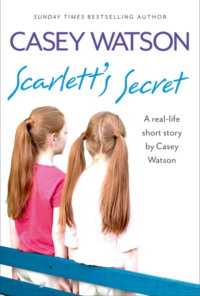Kitab fayl olaraq yüklənə bilməz, yalnız mobil tətbiq və ya onlayn olaraq veb saytımızda oxuna bilər.
Kitabı oxu: «Scarlett’s Secret: A real-life short story by Casey Watson»
Contents
Title Page
Scarlett’s Secret
Casey Watson
Moving Memoirs eNewsletter
Copyright
About the Publisher
Scarlett’s Secret
I’ve never been much of a one for long, boring meetings. Much less lectures – all that sitting still for ages, having to concentrate. I always get ants in my pants. But there was a talk I remember going to during my fostering training, which taught me something that’s always stayed with me. It was when the speaker, who was talking about what we could learn from kids’ behaviour, asked us to imagine communication like an iceberg. At the top – the part above the waterline – was the behaviour we could see, and beneath it – by far the greater part of any iceberg – were all the reasons why the child might be displaying that behaviour, but which we couldn’t see, and so could only guess at.
It seems self-evident, but it’s easy to forget, too. And it reminded me of one of the most valuable lessons I learned about communication: that when a child’s acting up there is always a deeper reason, and if we can find out what that reason is, rather than just labelling the child as ‘naughty’, then we have a much greater chance of dealing with the underlying problems. Take the other approach, and the child will just get naughtier.
None of which crossed my mind on the bright August morning when I met Scarlett and Jade – that only happened afterwards. I was busy reporting for duty as Team Leader for a youth-centred project, and was much too busy feeling excited about my new job. This was back before I’d ever thought of becoming a foster carer, even before I ran ‘The Unit’ in the local comprehensive school. This was back when my own kids were still in their mid-teens and I was a youth worker employed by the council.
Our work on these projects – each was about four months in duration – centred around recruiting and supporting NEETS. Lots of people know the term now because it’s in pretty common usage, but back then it was one of the trendy new buzzwords. It means Not in Employment, Education or Training Scheme and in this case that might mean kids with drug or alcohol issues, kids in care, kids who might have been in trouble with the law, as well as some who, for whatever reason, simply couldn’t find a job. Those were the kinds of kids we wanted to sign up for the course: kids who had slipped through the net and needed help. ones who lacked many of the skills they’d need to be a useful member of society and who, as a consequence, felt lost.
Far from being lost, my assistant, Katie, was all about this morning. And with her mane of hair and bouncy manner, I had privately nicknamed her Tigger; fresh out of uni, she was a blur of smiles and ambition and optimism, and had been a breath of fresh air on our two-week training course. I knew I was going to really enjoy working with her.
‘So,’ she said, jogging into the office, grinning widely, ‘ready for day three? Do we have a smiley-facey Casey, all ready to wow the troops?’
I laughed. That had been one of the edicts during training; the importance of us wearing our smiley faces at all times. (Except when we had to wear our stern ones, obviously.) But Katie didn’t need to put it on; her enthusiasm was infectious and it was clear the kids loved her. I was so pleased I had been part of the selection process when the bosses had been interviewing prospective candidates for the job. Yes, she was less experienced than the other candidates, but with her not being much older than the kids herself, she had an extra something that I didn’t. They seemed to know that she really understood where they were coming from.
‘We do indeed have a smiley Casey this morning,’ I said. ‘And we have lots to do before they arrive.’ I passed Katie a pile of papers and a stapler. ‘Here you go,’ I said. ‘You can put these into batches of three for me while I arrange the tables.’
The kids had an English test that morning, so we had to have a bit of a reshuffle of the arrangement we’d had the furniture in for the previous couple of days. The room that the council had allocated for us was in one of their large training centres, based on a small business estate, and was rather like a large classroom, which I hated. These students would not have long left at school and the last thing they would have wanted was yet another gloomy class to sit in. With that in mind, I had immediately Casey’d it up with bright pictures, comfortable scatter cushions, and colourful cups and saucers, etc. Part of the programme we offered included an adult qualification in Maths and English – it was about the only ‘schooly’ thing they did, and I wanted them to feel at ease when they did it.
Pulsuz fraqment bitdi.

